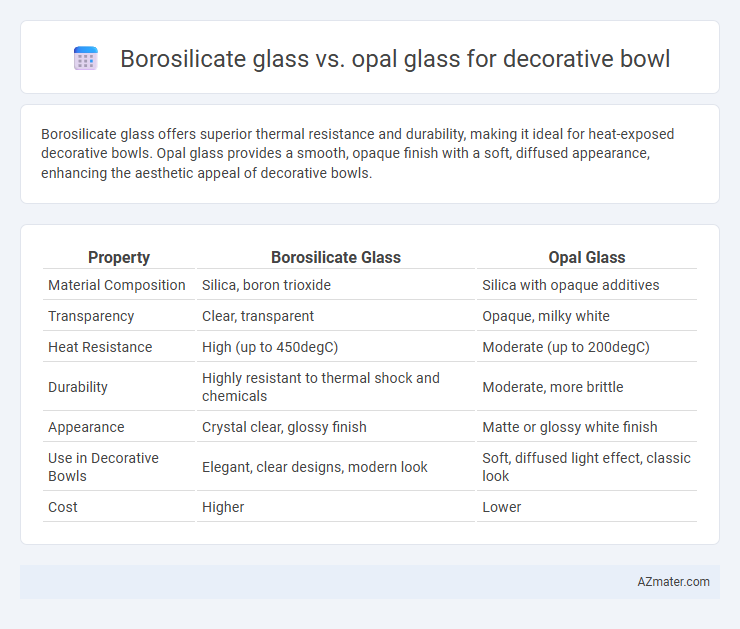Borosilicate glass offers superior thermal resistance and durability, making it ideal for heat-exposed decorative bowls. Opal glass provides a smooth, opaque finish with a soft, diffused appearance, enhancing the aesthetic appeal of decorative bowls.
Table of Comparison
| Property | Borosilicate Glass | Opal Glass |
|---|---|---|
| Material Composition | Silica, boron trioxide | Silica with opaque additives |
| Transparency | Clear, transparent | Opaque, milky white |
| Heat Resistance | High (up to 450degC) | Moderate (up to 200degC) |
| Durability | Highly resistant to thermal shock and chemicals | Moderate, more brittle |
| Appearance | Crystal clear, glossy finish | Matte or glossy white finish |
| Use in Decorative Bowls | Elegant, clear designs, modern look | Soft, diffused light effect, classic look |
| Cost | Higher | Lower |
Introduction to Decorative Glass Bowls
Borosilicate glass and opal glass both serve as popular materials for decorative bowls, each offering unique aesthetic and functional benefits. Borosilicate glass is renowned for its durability, thermal resistance, and clarity, making it ideal for contemporary, sleek designs that emphasize transparency. Opal glass provides a soft, opaque finish with a smooth, matte surface that enhances decorative appeal through diffused light and subtle elegance, favored in vintage or artisan-style bowls.
Understanding Borosilicate Glass
Borosilicate glass stands out in decorative bowls due to its exceptional thermal resistance and durability, making it less prone to cracking under temperature changes compared to opal glass. Its high silica content and low coefficient of thermal expansion provide superior strength and clarity, ideal for showcasing intricate designs in home decor. Unlike opaque opal glass, borosilicate offers a transparent or translucent finish that enhances light reflection and visual appeal in decorative pieces.
Key Features of Opal Glass
Opal glass is a type of decorative glass known for its smooth, milky-white appearance and excellent light diffusion, making it ideal for ornamental bowls that require a soft, elegant glow. Its non-porous surface enhances durability and stain resistance, ensuring long-lasting beauty and easy maintenance. Compared to borosilicate glass, opal glass offers superior aesthetic appeal with a distinctive opaque finish, although it is less heat-resistant and more prone to chipping.
Aesthetic Appeal: Borosilicate vs Opal Glass
Borosilicate glass offers a crystal-clear transparency and sleek modern finish, enhancing decorative bowls with a sophisticated, minimalist aesthetic ideal for showcasing intricate internal details. Opal glass provides a milky, diffused translucency that imparts a warm, soft glow and vintage charm, creating an inviting and artistic appearance in decorative bowls. The choice between borosilicate and opal glass hinges on whether sharp clarity or gentle luminosity better complements the bowl's design and setting.
Durability and Strength Comparison
Borosilicate glass exhibits superior durability and resistance to thermal shock compared to opal glass, making it ideal for decorative bowls subjected to temperature variations. Its high mechanical strength reduces the risk of chipping and cracking during handling or accidental impacts, whereas opal glass, while aesthetically pleasing with its opaque finish, tends to be more brittle and prone to breakage. The chemical composition of borosilicate, containing boron trioxide, enhances its structural integrity, offering longer-lasting performance in decorative applications than opal glass.
Heat Resistance and Practical Use
Borosilicate glass offers superior heat resistance up to 450degC, making it ideal for decorative bowls exposed to thermal stress or fluctuating temperatures. Opal glass, while aesthetically appealing with its opaque, milky finish, has lower heat resistance, typically around 120degC, limiting its use to purely decorative or low-heat environments. Practical use favors borosilicate glass for durability and safety in hot settings, whereas opal glass excels in artistic design without intense heat exposure.
Maintenance and Cleaning Differences
Borosilicate glass offers superior resistance to thermal shock, making it easier to clean with both hot water and abrasive cleaners without risk of damage, whereas Opal glass is more delicate and prone to surface scratches or dulling when exposed to harsh cleaning agents. Maintenance of Borosilicate glass bowls requires less frequent polishing and is less susceptible to staining due to its non-porous surface, while Opal glass demands gentle hand washing with mild detergents to preserve its opaque finish and prevent surface wear. The durability and chemical resistance of Borosilicate glass reduce long-term upkeep compared to Opal glass, which necessitates careful handling to maintain its decorative appearance.
Sustainability and Environmental Impact
Borosilicate glass offers superior durability and thermal resistance, resulting in a longer lifespan that reduces the frequency of replacements and minimizes waste. Opal glass, while aesthetically appealing, generally requires more energy-intensive manufacturing processes and features lower breakage resistance, leading to higher environmental impact over time. Opting for borosilicate glass in decorative bowls supports sustainability by lowering resource consumption and favoring recyclability.
Cost Considerations
Borosilicate glass typically incurs higher costs due to its heat resistance and durability, making it a premium choice for decorative bowls that require long-term resilience. Opal glass offers a more affordable alternative with a smooth, opaque finish, ideal for aesthetic appeal without the need for thermal performance. Budget-conscious buyers often prefer opal glass for decorative bowls when cost savings outweigh the benefits of borosilicate's robustness.
Choosing the Right Glass for Decorative Bowls
Borosilicate glass offers superior thermal resistance and durability, making it ideal for decorative bowls exposed to temperature fluctuations or daily use. Opal glass provides an elegant, opaque translucency with a smooth finish, preferred for purely aesthetic purposes and softer light diffusion. Selecting the right glass depends on whether functional resilience or visual appeal is the priority for the decorative bowl's intended environment.

Infographic: Borosilicate glass vs Opal glass for Decorative bowl
 azmater.com
azmater.com